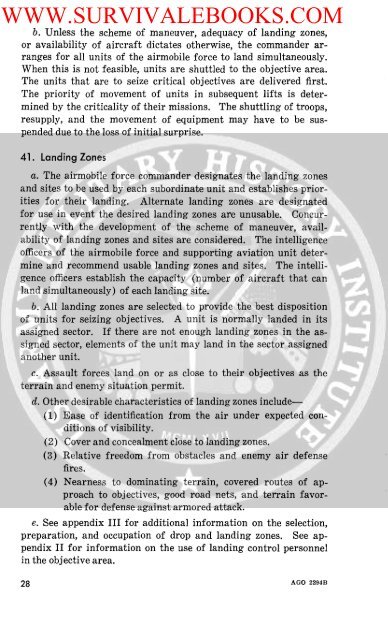FM 57-35 Airmobile Operations - Survival Books
FM 57-35 Airmobile Operations - Survival Books
FM 57-35 Airmobile Operations - Survival Books
- No tags were found...
You also want an ePaper? Increase the reach of your titles
YUMPU automatically turns print PDFs into web optimized ePapers that Google loves.
WWW.SURVIVALEBOOKS.COMb. Unless the scheme of maneuver, adequacy of landing zones,or availability of aircraft dictates otherwise, the commander arranges for all units of the airmobile force to land simultaneously.When this is not feasible, units are shuttled to the objective area.The units that are to seize critical objectives are delivered first.The priority of movement of units in subsequent lifts is determined by the criticality of their missions. The shuttling of troops,resupply, and the movement of equipment may have to be suspended due to the loss of initial surprise.41. Landing Zonesa. The airmobile force commander designates the landing zonesand sites to be used by each subordinate unit and establishes priorities for their landing. Alternate landing zones are designatedfor use in event the desired landing zones are unusable. Concurrently with the development of the scheme of maneuver, availability of landing zones and sites are considered. The intelligenceofficers of the airmobile force and supporting aviation unit determine and recommend usable landing zones and sites. The intelligence officers establish the capacity (number of aircraft that canland simultaneously) of each landing site.b. All landing zones are selected to provide the best dispositionof units for seizing objectives. A unit is normally landed in itsassigned sector. If there are not enough landing zones in the assigned sector, elements of the unit may land in the sector assignedanother unit.c. Assault forces land on or as close to their objectives as theterrain and enemy situation permit.d. Other desirable characteristics of landing zones include(1) Ease of identification from the air under expected conditions of visibility.(2) Cover and concealment close to landing zones.(3) Relative freedom from obstacles and enemy air defensefires.(4) Nearness to dominating terrain, covered routes of approach to objectives, good road nets, and terrain favorable for defense against armored attack.e. See appendix III for additional information on the selection,preparation, and occupation of drop and landing zones. See appendix II for information on the use of landing control personnelin the objective area.28 AGO 2294B
















